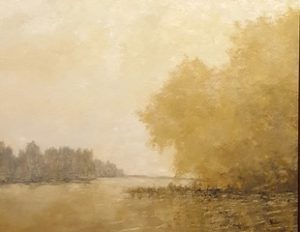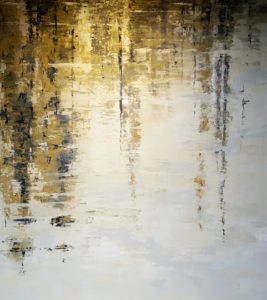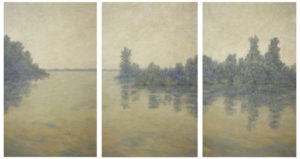For the record, Tabby Ivy’s paintings reached me sooner than Tabby Ivy. What reached me in her paintings is their essential quiet, their silence. Silence in a work of art is something I anticipate. If there is silence in a painting—or in a poem or play or work of prose or a piece of music—then I trust silence will touch me.
In paintings such as “Gently the River Flows,” “Autumn Interlude,” “River Reverie” and others, silence speaks both within and on the other side of representation. Within is what is near to us, what is immediate. In “Gently the River Flows” I am close to this quiet place. The willows yellowed from autumn and the sky ease me as autumn and the sky ease me. In them, I become quiet. Then I smell the conifers on the other side of the river. Their scent is carried on the breeze and current just gracing the river. The blends of ochre and blushes of sienna are there. I can stand close to them. Yet whether I stand close or away, what reaches for me, what begs me to stop, is the silence.

To recognize this silence, I must see what I have called the other side of representation. Look closely, then look even closer. See beneath the sky reflected in the river. Look through the sky, as the brush strokes invite us to look. Then look at the edge of the horizon, at the distant lineation of another shore, and notice how it is touched by something farther away than even the painter can paint. This is where silence begins. They are real—these places within the painting and the silence they echo. They are as real as the painting, the painter, and the person looking.

I can discover similar moments in other of Ivy’s paintings. Notice the spaces painted into “Autumn Interlude.” See how light harbors the treetops in “River Reverie.” Spaces and light and the silence they carry are what came to me first in Tabby Ivy’s work. Only later did I meet the painter herself. She is more gracious than I could have imagined. She is warm. She laughs. She shares and listens to stories.
I hope to go on sitting with Tabby’s paintings. I am selfish, however. I want or will need them to remind me of places I have forgotten or of places that once touched me. In such a moment, I will also be reminded of what should be close—rivers and seasons, reflections, colors and textures that demand another look. But it is their silence that will carry me. And if I am patient, if I do not get in my own way, then maybe I will see and hear what more this silence keeps.
